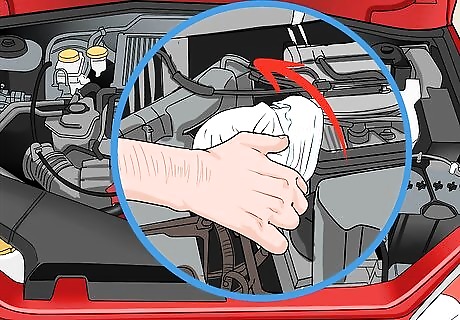
views
Preparing to Clean Your Vehicle

Make sure the engine is cold. The only time you should wash under the hood is when the engine is cold. This means that you need to wait a substantial time after running the engine and washing under the hood. If you wash it when the engine is hot, you run the risk of damaging your engine as cold water may cause hot or warm parts to shatter or be damaged. The best time to wash under the hood is in the morning after your engine has cooled all night. Some experts suggest that it is okay to clean the engine while it is slightly warm. They note that this can help in the process of removing dirt and gunk. However, it is best to exercise caution and may be best to wait until the engine is cold. Never wash under the hood immediately after you’ve been driving the car.

Cover the vulnerable parts of the engine. Before washing under the hood, you need to make sure that you cover or protect a number of parts that might be damaged by water. This is best done by securing vulnerable components with plastic bags and plastic tape. Cover or protect the engine’s air intake. Cover or protect the alternator. Protect any electronics, electrical connections, relays, or sensors. Cover or protect the distributor cap. It is easy for water to get under the cap. Make sure to cover it with plastic and secure the plastic with tape. If you get water under the cap, you can spray WD-40 to help dissipate the water. If this does not work, you may need to replace the cap and rotor. If you have doubts about the damage water may do to a certain part of your engine, cover it.

Take the filters out of the engine compartment. The next step is to take out any filters that could be damaged or ruined. This is important since filters are extremely vulnerable to water and are places where water could accumulate and potentially harm the engine or other parts. The most likely filter you'll have to remove is the engine air intake filter. Rarely, if it is exposed in the engine compartment, you may need to remove the cabin air filter, too. Make sure to cover any filter intakes with plastic, just as you did with sensitive electronics and other areas. Store the filters in a dry and clean place. Make sure you put the filters in a place you won’t forget them. It is imperative that all filters are replaced after you wash the engine compartment.

Remove the battery cables. Before continuing on to clean under the hood, you need to make sure you’ve removed the car’s battery cables. This is important since you’ll be introducing water into the engine compartment which could possibly produce a short in your vehicle. Find an appropriate sized socket to loosen the nuts that fasten the cables to the battery. Take off the negative cable. Disconnect the positive cable. Do not let the positive cables touch any metal part of your car. This could cause a short in your vehicle. Place the cables on a table or in your garage where they won’t be exposed to water.

Gather your supplies. Now that you’ve prepared your car, you need to gather the rest of the supplies you’ll need to proceed. It is important you have everything you’ll need, so you can wash under the hood quickly and effectively and make sure that all water is removed when you are finished. Make sure to have: Car washing soap (non-wax or polymer). Microfiber clothes. Degreaser. A hose and sprayer with a low-pressure setting. Rubber or vinyl protectant for cars.
Cleaning Under the Hood

Spray the degreaser on non-sensitive areas. Before you introduce water into your engine, you should spray a degreaser on non-sensitive metal parts in your engine compartment. The degreaser will help loosen grease when you go to spray down the engine. Take your degreaser and spray it throughout the engine compartment. Avoid sensitive areas with electronic connections. Degreasing hoses and fluid containers is okay. Do not spray the degreaser on areas where it might leak or drain into the engine itself. Let the degreaser sit for several minutes.

Rinse your engine. After you’ve let the degreaser sit, you should rinse down your engine with regular, low pressure water. Rinsing the water will help remove dirt, grime, and degreaser. This will help you avoid scratching sensitive plastics or metals later in the washing process. Your rinse job should be low pressure and low volume. Use a spray or spritz setting on your hose’s sprayer. Do not flood the engine compartment with water. Go slow and go easy. Pay special attention to areas you’ve degreased, and make sure to rinse out the degreaser.

Wipe down your engine compartment with a soap and water mixture. After you’ve degreased and rinsed, take a soap and water mixture and wipe down your engine compartment. Wiping down the engine compartment with soap and water will help remove remnant degreaser as well as dirt and grime. Use a microfiber cloth. Avoid soaps that include any wax or polymers. Make sure you follow the directions on your soap’s bottle and dilute it properly. Wipe gently and pay attention to areas with excess amounts of grime.

Spray down your engine compartment, again. After you’ve wiped down the engine compartment with soap and water, you’ll need to rinse it again. As with the previous rinsing, make sure to go slow and use low pressure. The goal is to remove soap and grime while making sure that water does not enter any sensitive areas.

Dry off your engine. The next step will be to dry off your engine. Unlike with washing a car, you want to avoid air drying so that all water is removed from the engine compartment as quickly as possible. This will help ensure that water doesn’t get into sensitive areas. Dry your engine compartment with microfiber towels. Pay special attention to hard to reach areas and areas where water may accumulate and may not drain. Wipe down the coil pack/distributor/alternator and other similar areas.
Returning Your Car to Working Order

Remove the plastic bags that are protecting sensitive parts of your engine. After you’ve dried the majority of your engine, remove all plastic bags you used to protect sensitive parts of your engine. This will enable you to continue cleaning and proceed toward finishing the project. Be diligent about removing all plastic and tape from the engine. If you leave anything, it could damage your engine. Wipe down plastic bags before removing them, just to be safe.

Apply protectants to rubber and vinyl parts. After you’ve dried your engine off, go through and apply your favorite (car approved) protectants to vinyl and rubber surfaces in the engine. This way, your engine will not only look clean, but will have a new appearance and will be protected. Protectants will help prolong the life of rubber and vinyl parts in your engine bay. Feel free to wax painted surfaces in the engine, but know that your wax will probably not last long because of the heat. As with degreaser, soap, and water, avoid applying protectants to sensitive areas that you covered with plastic.

Reattach the battery cables and reinsert the filters. Now that you’ve removed all plastic and dried the engine, and applied protectants, it will be time to reattach the battery cables, reinsert the filters, and otherwise return your engine bay to the condition it was in before you began to wash it. This way, your car will run just the way it did before, but the engine bay will be cleaner.




















Comments
0 comment